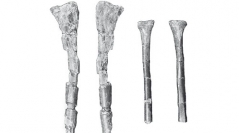

 Geodiversitas
34 (4) - Pages 883-894
Geodiversitas
34 (4) - Pages 883-894Varricchio (2002) described some forelimb bones from the Late Cretaceous (Campanian) Two Medicine Formation, Glacier County, Montana (USA), as the holotype of Piksi barbarulna, a supposed ornithothoracine bird. However reevaluation of Piksi Varricchio, 2002 instead recognizes this genus as belonging to Pterosauria Kaup, 1834 and not Aves Linnaeus, 1758. Piksi exhibits the following derived humeral traits of pterosaurs: 1) very large ectepicondyle; 2) large trochlea; 3) with a deep, wide and poorly deliminated brachial depression that is proximodistally extended; 4) a wide and deep olecranal fossa not marked dorsally by a ridge; and 5) lacking a distal depression of the groove for the m. humerotricipitalis. Moreover, the putative Early Cretaceous birds Eurolimnornis Jurcsák & Kessler, 1986 and Palaeocursornis Jurcsák & Kessler, 1986, based on distal humeri, are also regarded as pterosaurs. The record of Piksi constitutes an important addition to the Latest Cretaceous pterosaurian record.
Pterosauria, Late Cretaceous, North America